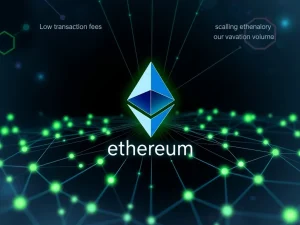Alarming Drop: Ethereum Revenue Plummets 44% Amid Record ETH Price Highs

The cryptocurrency world recently witnessed a puzzling paradox: **Ethereum revenue** experienced a significant decline in August, even as the **ETH price** soared to unprecedented levels. This situation has sparked considerable debate within the community, prompting closer examination of Ethereum’s underlying financial health and future trajectory. Many investors are now asking what this means for the network’s long-term sustainability.
Understanding the Ethereum Revenue Decline
Ethereum’s network revenue, which represents the portion of transaction fees burned and thus accrues to Ether (ETH) holders, fell by approximately 44% in August. This substantial drop occurred despite a remarkable surge in the **ETH price**, which rallied by 240% since April and hit an all-time high of $4,957 on August 24. Specifically, revenue for August totaled just over $14.1 million, a sharp decrease from July’s $25.6 million, according to data from Token Terminal. Network fees also mirrored this trend, dropping by about 20% month-over-month, from roughly $49.6 million in July to $39.7 million in August.
This revenue model is crucial for Ethereum’s deflationary mechanism, known as EIP-1559. A significant portion of transaction fees is permanently removed from circulation, potentially increasing the scarcity and value of ETH over time. Therefore, a decline in revenue directly impacts the rate of this token burn, which in turn influences the network’s economic dynamics.
The Impact of the Dencun Upgrade on Fees
A primary factor behind the dwindling fees and revenue is the monumental **Dencun upgrade**, implemented in March 2024. This upgrade fundamentally altered Ethereum’s fee structure, particularly for **Layer-2 scaling** solutions. Before Dencun, Layer-2 networks, which process transactions off-chain and then batch them onto the Ethereum mainnet, faced high costs for posting their data. The Dencun upgrade introduced ‘proto-danksharding’ and ‘blobs’ (Binary Large Objects), dramatically reducing the cost for Layer-2s to record transactions on the base layer. This innovation effectively lowered transaction fees for end-users on these scaling networks.
While beneficial for user experience and network scalability, the Dencun upgrade has an immediate consequence for Ethereum’s direct revenue. Lower fees on Layer-2s mean less overall fee generation for the mainnet, even as transaction volume potentially shifts to these more affordable solutions. Consequently, this change has ignited a debate about the viability of Ethereum’s current economic model:
- **Critics** argue that the Layer-1 smart contract platform now faces unsustainable financial fundamentals due to reduced fee income.
- **Proponents**, however, maintain that Ethereum is solidifying its position as the indispensable backbone of the future financial system, with Layer-2s serving as its efficient arteries.
Surging Institutional Interest in Ethereum
Despite the revenue challenges, Ethereum has experienced an eventful 2025, largely driven by burgeoning **institutional interest**. Wall Street firms and public treasury companies are increasingly recognizing Ethereum’s potential, contributing significantly to the recent **ETH price** rallies. For instance, Etherealize, a dedicated advocacy and public relations firm, successfully completed a $40 million capital raise in September. This funding aims to market the Ethereum network directly to publicly traded companies, highlighting its enterprise-grade capabilities and investment opportunities.
Investment firm Bitwise’s Chief Investment Officer, Matt Hougan, emphasized the appeal of Ether’s unique yield-bearing features to traditional financial investors. He explained, “If you take $1 billion of ETH and you put it into a company and you stake it, all of a sudden, you’re generating earnings. And investors are really used to companies that generate earnings.” This statement underscores a critical differentiator for Ethereum in the institutional landscape.
The Allure of Staking for Institutional Investors
A key driver of this institutional engagement is the ability to stake Ethereum. Staking involves locking up ETH tokens to help secure the network and validate transactions. In return, stakers earn a yield, essentially generating passive income for providing validation services to the Layer-1 blockchain. This mechanism transforms ETH from a purely speculative asset into a productive, yield-generating one, a characteristic highly valued by traditional finance. Institutional entities are actively exploring and implementing strategies to incorporate staked ETH into their portfolios, recognizing its potential for stable returns in a volatile market.
The increasing participation of large financial players in staking not only bolsters network security but also integrates Ethereum more deeply into conventional financial frameworks. This trend suggests a maturation of the cryptocurrency market, moving beyond retail speculation to encompass sophisticated investment strategies. The concept of Ethereum treasury companies, which hold ETH as a primary asset and engage in staking, could potentially ignite a ‘DeFi Summer 2.0,’ fostering a new wave of decentralized finance innovation and adoption.
Navigating Ethereum’s Evolving Financial Landscape
The current scenario presents a nuanced picture for Ethereum. While the **Dencun upgrade** has optimized **Layer-2 scaling** and reduced user costs, leading to a temporary dip in direct **Ethereum revenue**, it has simultaneously enhanced the network’s long-term utility and appeal. This strategic shift positions Ethereum as a more efficient and accessible base layer, which could ultimately drive greater adoption and value. The continued surge in **institutional interest** and the recognition of ETH’s yield-bearing properties further strengthen its foundation, despite the immediate revenue figures.
Investors and market watchers will closely monitor how these dynamics evolve. The balance between maintaining a robust fee-burning mechanism and fostering an accessible, scalable ecosystem remains central to Ethereum’s success. As the network matures and integrates further with traditional finance, its ability to adapt and innovate will determine its enduring role as a global financial backbone.








